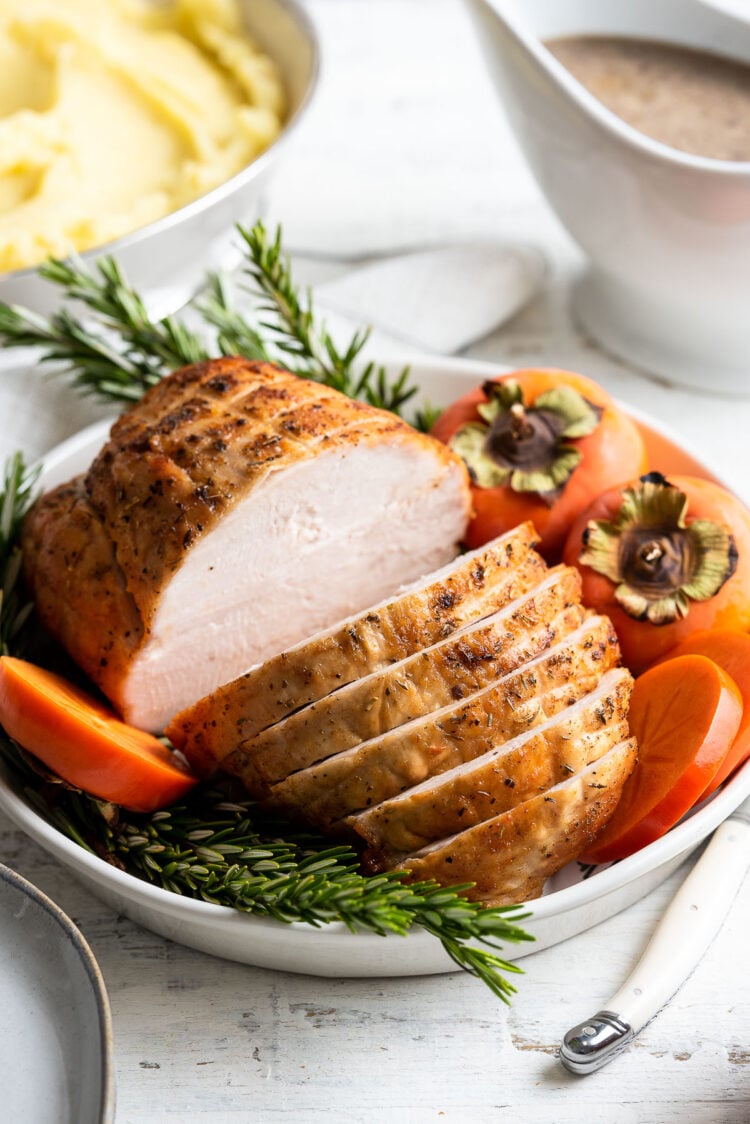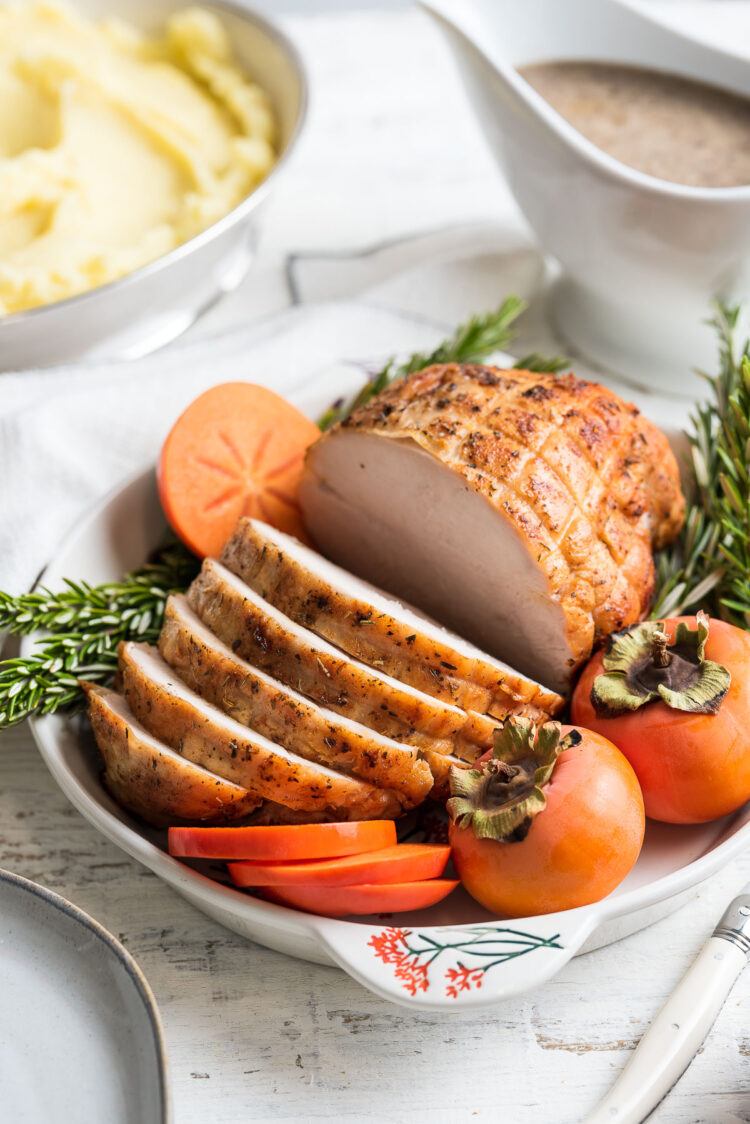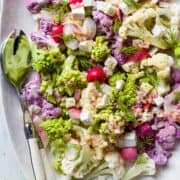
Roasted Boneless Turkey Breast
Roasted Boneless Turkey Breast is perfect for smaller celebrations or even a weeknight meal. It is simple to prepare, without the fuss of a full turkey — learn how to cook a boneless turkey breast!

Roasted Boneless Turkey Breast is perfect for smaller celebrations, Friendsgiving, cozy holidays, Thanksgiving with fewer meat eaters, or even a weeknight meal. It is simple to prepare, without the fuss of a full turkey!

In Thanksgivings past, we used to roast the largest turkey we could get our hands on, irregardless if we were cooking for two or hosting extended family. Either way, it never got wasted, since turkey leftovers were always welcome, and we could always throw it into a soup or make a large batch of pressure cooker soup stock.
But with each passing year, I haven’t been as ambitious with cooking a 20 lb turkey. As a family, we eat less meat, and since my pescatarian daughter isn’t consuming her previous share, there really isn’t a need for the whole bird.
Roasting a turkey breast is the perfect solution.
There is, of course, the decision: boneless turkey breast or bone-in? For its simplicity, I like opting for the boneless turkey breast – it’s compact, I don’t have to deal with bones, and typically, it comes rolled and tied, ready for the oven.
The boneless turkey breast option makes it a wonderful option for smaller holiday meals, Thanksgiving with fewer meat eaters, or even a simple weeknight meal. Why wait for Thanksgiving? It’s that easy!

Boneless Turkey Breast Cooking Tips
Many of these tips are helpful whether you are cooking a boneless turkey breast in the oven, or the whole bird, and will help you achieve a roast turkey that has golden skin, and juicy, evenly cooked meat!
Netting:
- Typically, boneless turkey breasts are sold with netting. Be sure to keep the netting on, since this helps keep the shape of the turkey.
- If you happened to purchased the boneless turkey breast from your butcher without any netting, feel free to sprinkle some of the salt mixture between the skin and the meat before trussing.
Kosher salt:
- The quality of your salt really makes a difference. In all my recipes, my first choice is Diamond Crystal (affiliate link) salt. Because of its crystal structure, it’s not as salty as table salt, or even other kosher salt brands.
- If you choose to use a different style or brand of salt, please make adjustments and use less salt.
Be sure to pat the turkey dry before seasoning, and if your turkey comes tied, keep the netting in during roasting. A simple blend of salt and spices adds flavor to turkey. For maximum flavor, dry brine the turkey before roasting.
Dry Brining:
- Allowing the turkey to rest in the refrigerator with the salt rub is a process known as dry-brining, which is typically done for around 6 hours to overnight. I find that 1 hour of dry brining is just fine, especially for smaller turkey breasts, which saves time and space in the refrigerator.
- If you wish to skip the dry brining process, that is fine too – just season the meat right before you place it in the oven. However, there is a benefit to allowing the turkey to sit uncovered in the refrigerator – this time airs and dries out the skin of the turkey, resulting in a crispy skin.
Roasting room temperature turkey:
- Like with any meat, giving the turkey time to sit at room temperature before placing in the oven helps get the chill off, resulting in more evenly cooked meat.
Season the turkey liberally on all side and let it rest in the refrigerator. Roast the turkey on a wire rack in a shallow rimmed baking sheet to allow for browning on all sides.
How long to cook boneless turkey breast in oven:
- Roasting time can vary, depending on the size and shape of your boneless turkey breast. Some are squat and thick, while others are thinner and more oblong. Keep this in mind and check your turkey with a thermometer.
Resting the turkey after roasting:
- As tempting as it is, give your turkey some time to rest at room temperature before carving. Not only does the turkey continue cooking for a few minutes as it rests, the juices also get reabsorbed into the meat – this is critical for juicy, succulent meat staying in the turkey and not all over your cutting board.

More Thanksgiving Recipes
Savory Herb Stuffing Bread
Pesto Pull-Apart Rolls
Butternut Squash Creamed Corn
Roasted Acorn Squash and Kale Salad
Roasted Butternut Squash Winter Salad with Kale, Farro and Cranberry Dressing
Cassava Pumpkin Pie with Graham Cracker Crust
Buttermilk Brined Cornish Hens
Pumpkin Leche Flan
Thanksgiving Leftover Recipes
Mashed Potato and Stuffing Waffles
Cranberry Hand Pies
Day-After Turkey Shepherd’s Pie
Cranberry Sauce Cornbread Muffins
Turkey Pumpkin Pot Pie
Cranberry Sauce Granola

Roasted Boneless Turkey Breast
Ingredients
- 1 3-4 lb boneless turkey breast
- 1 1/2 tablespoons kosher salt i.e. Diamond Crystal brand
- 1 1/2 teaspoons paprika
- 1 teaspoon Herbes de Provence
- Olive oil spray
Instructions
- Pat the turkey breast dry with paper towels and place on a wire rack over a rimmed baking sheet. Chances are your boneless turkey breast is wrapped with netting; keep the netting on.
- In a small bowl, stir together the kosher salt, paprika, and Herbes de Provence. Sprinkle the salt mixture over the turkey, patting it on to evenly coat the meat on all sides. Discard any unused salt.
- Chill the turkey in the refrigerator, uncovered, for 1 hour, or overnight (see notes).
- Preheat the oven to 450°F with a rack placed in the center of the oven. Remove the turkey from the refrigerator and let it sit at room temperature for 30 minutes, while the oven comes to temperature.
- Spray the turkey breast with olive oil and place in the oven to roast for 20 minutes. Lower the heat to 350°F, and continue roasting for another 30 minutes to an hour, or until a thermometer inserted in the thickest part of the turkey breast reaches 160°F. Depending on the shape of your boneless turkey breast, roasting times may vary, so be sure to check the temperature periodically towards then end of roasting.
- Remove the turkey breast from the oven and let it rest at room temperature for 15-20 minutes before discarding the net and slicing.
Notes
- Netting:
- Typically, boneless turkey breasts are sold with netting. Be sure to keep the netting on, since this helps keep the shape of the turkey.
- If you happened to purchased the boneless turkey breast from your butcher without any netting, feel free to sprinkle some of the salt mixture between the skin and the meat before trussing.
- Kosher salt:
- The quality of your salt really makes a difference. In all my recipes, my first choice is Diamond Crystal (affiliate link) salt. Because of its crystal structure, it’s not as salty as table salt, or even other kosher salt brands.
- If you choose to use a different style or brand of salt, please make adjustments and use less salt.
- Dry Brining:
- Allowing the turkey to rest in the refrigerator with the salt rub is a process known as dry-brining, which is typically done for around 6 hours to overnight. I find that 1 hour of dry brining is just fine, especially for smaller turkey breasts, which saves time and space in the refrigerator.
- If you wish to skip the dry brining process, that is fine too – just season the meat right before you place it in the oven. However, there is a benefit to allowing the turkey to sit uncovered in the refrigerator – this time airs and dries out the skin of the turkey, resulting in a crispy skin.
- Roasting room temperature turkey:
- Like with any meat, giving the turkey time to sit at room temperature before placing in the oven helps get the chill off, resulting in more evenly cooked meat.
- Roasting time:
- Roasting time can vary, depending on the size and shape of your boneless turkey breast. Some are squat and thick, while others are thinner and more oblong. Keep this in mind and check your turkey with a thermometer.
- Resting turkey after roasting:
- As tempting as it is, give your turkey some time to rest at room temperature before carving. Not only does the turkey continue cooking for a few minutes as it rests, the juices also get reabsorbed into the meat – this is critical for juicy, succulent meat staying in the turkey and not all over your cutting board.




















Comments